

Cancer.
Non-ionising radiation - Optical radiation. The Control of Artificial Optical Radiation at Work Regulations 2010 The Control of Artificial Optical Radiation at Work Regulations [1] came into force on 27 April 2010 and aim to protect workers from the risks to health from hazardous sources of artificial optical radiation (AOR).

Workers in Great Britain are generally well protected from AOR and the majority of businesses with hazardous sources know how to manage the risks effectively. Further work is only expected to be undertaken by those businesses that use hazardous sources of AOR and where the associated AOR risks have not already been reduced to as low as is reasonably practicable.
We have produced guidance to help dutyholders decide whether they are already protecting their workers or whether they need to do more under the new regulations. UV exposure [7] in the pages about cancer/reducing risk. The Control of Artificial Optical Radiation at Work Regulations 2010. UK Guidance for Employers on AOR. Radiation vs Radioactive Atoms. IDTIMWYTIM: Radiation. Atoms and Isotopes. A-level Physics/Forces, Fields and Energy/The nuclear atom - Wikibooks, open books for an open world. Up until the 19th century, atoms were once thought to be the smallest building blocks of matter, and that matter could not be broken down any further.
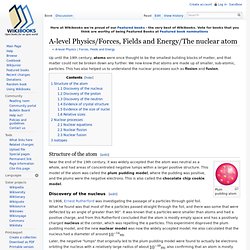
We now know that atoms are made up of smaller, sub-atomic, particles. This has also helped us to understand the nuclear processes such as fission and fusion. Force fields near a neutron or proton. Isotopes. Isotope notation. The structure of the atom. Table of the charge of atoms. Electromagnetic fields and public health: mobile phones. How Cell-phone Radiation Works" When talking on a cell phone, a transmitter takes the sound of your voice and encodes it onto a continuous sine wave (see How Radio Works to learn more about how sound is transmitted).
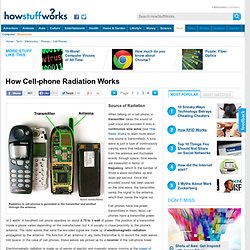
A sine wave is just a type of continuously varying wave that radiates out from the antenna and fluctuates evenly through space. Sine waves are measured in terms of frequency, which is the number of times a wave oscillates up and down per second. Once the encoded sound has been placed on the sine wave, the transmitter sends the signal to the antenna, which then sends the signal out. Cell phones have low-power transmitters in them. Most car phones have a transmitter power of 3 watts. Cell Phone Radio Waves Excite Brain Cells.
Hide captionA new study finds that radio waves from a cell phone can affect the metabolism of brain cells, though there is no evidence that the effect is harmful.
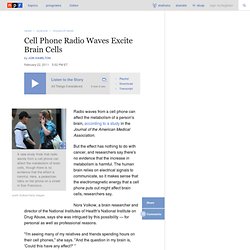
Here, a pedestrian talks on her phone on a street in San Francisco. Justin Sullivan/Getty Images A new study finds that radio waves from a cell phone can affect the metabolism of brain cells, though there is no evidence that the effect is harmful. Here, a pedestrian talks on her phone on a street in San Francisco. Cell Phone Study: Cell Use Ups Brain Activity. <br/><a href=" US News</a> | <a href=" Business News</a> Copy Fears concerning the possible dangers of prolonged cell phone use won't go away, despite numerous studies showing no conclusive link between cell phones and brain tumors or cancer.

Radiation references. Radiation Shielding Materials Containing Hydrogen, Boron, and Nitrogen: Systematic Computational and Experimental Study. Radiation Shielding Materials Containing Hydrogen, Boron, and Nitrogen: Systematic Computational and Experimental Study Sheila Thibeault NASA Langley Research Center The objectives and expected significance of the proposed research are to develop a space radiation shielding material system that has high efficacy for shielding radiation and that also has high strength for load bearing primary structures.

Such a material system does not yet exist. The NASA Langley Research Center (LaRC), Jefferson National Lab (JNL), and National Institute of Aerospace (NIA) as joint owners have recently synthesized long, highly crystalline boron nitride nanotubes (BNNT) using a novel pressure/vapor condensation method. The BNNT have extraordinary strength and high temperature stability. Active Radiation Shielding Utilizing High Temperature Superconductors. A Force Field for Astronauts?
Researchers are reviving an old but wild idea to protect astronauts from space radiation. + Play Audio | + Download Audio | + Historia en Español | + Join mailing list June 24, 2005: Opposite charges attract.
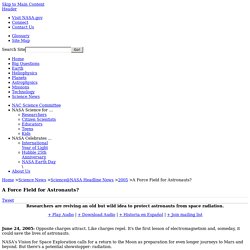
Like charges repel. It's the first lesson of electromagnetism and, someday, it could save the lives of astronauts. NASA's Vision for Space Exploration calls for a return to the Moon as preparation for even longer journeys to Mars and beyond. Space beyond low-Earth orbit is awash with intense radiation from the Sun and from deep galactic sources such as supernovas. Right: Supernovas produce dangerous radiation. The most common way to deal with radiation is simply to physically block it, as the thick concrete around a nuclear reactor does. Those are all physical solutions. Space Faring: The Radiation Challenge.
Space Trash May Make Radiation Shields. Radiation shields, new engines mandatory for Mars. Radiation shields, new engines mandatory for Mars BY STEPHEN CLARKSPACEFLIGHT NOWPosted: 31 May 2013 A detector on NASA's Curiosity rover has confirmed previous research findings on the hazards of space radiation on the way to Mars, scientists announced Thursday, and future astronauts making the trip will need protection from the danger.
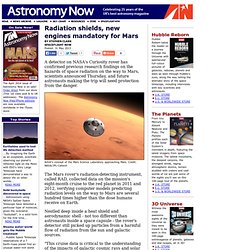
Artist's concept of the Mars Science Laboratory approaching Mars. Credit: NASA/JPL-Caltech The Mars rover's radiation-detecting instrument, called RAD, collected data on the mission's eight-month cruise to the red planet in 2011 and 2012, verifying computer models predicting radiation levels on the way to Mars are several hundred times higher than the dose humans receive on Earth.